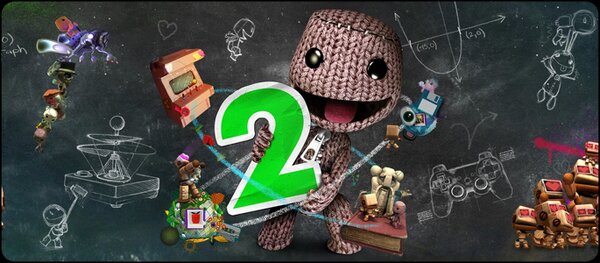A Little Bit About Media Molecule’s Big Game
I know I am a bit late to the party on this, but I have recently been enthralled with the Playstation 3’s “Little Big Planet” series which was developed by Media Molecule. Before you go and check your browser, you are in fact at FuelYourMotionography.com and not some game reviewing site. Why write about games for a motion design site? Well, the games have gorgeous credit sequences that give you the basics of gameplay while playfully showing the people who created the game you are playing. The second game, aptly named “Little Big Planet 2”, incorporates some very interesting interactive elements.
For those unfamiliar, the “Little Big Planet” series are puzzle platformer video games. At least that is how the Wikipedia page defines them. Basically you run across the screen and have the fore, middle and background to swap between while doing so. They are also narrated by Stephen Fry, and that I find quite amusing. However, the important part for us now is the design.
Both games start with a short video where the concept and ideology behind the games are presented (in short: play, design, share). The theme of these are imagination coming to life, which is the seed of the idea that the game springs from. For the second game, this is represented by a child playing a scientist, musician, a ballon salesmen in a bowtie and others, all surrounded by a growing level of imagination taken from, or in the style of, design from the game. These are great pieces, especially with the Stephen Fry voice over, that most likely get skipped by the majority of people playing but are a joy to watch and well worth the time.
Following the video is the starting tutorial, where the games design takes over in ernest. Your character, a “sackperson,” is dropped into the world where the voice over guides you in learning the ropes. While you run, the sets change with their themes lushly represented. The first starts off in a sort of notebook sketch brought to life. Paper airplanes fly in an arc in the background, and shredded paper make up much of the foliage.
Little Big Planet 2’s first interactive title area is a nightclub theme complete with large dancing speaker stacks and a rotating wheel of heads of some of the people involved with making the game. A bouncy pad lets you leap into the air and going in front of a portrait causes something different for each person. It makes me wonder if these elements, from halos to hearts and even lighting bolts, are inside jokes or something about the personality of their respective people.
As you continue to run through this tutorial level, you come to a point where old style arcade games signal the games other interactive credits section. This one takes on a style of a Galaga or Space Invaders with an endless loop of the other portraits from some of the people responsible for the game. While in this set piece a rocket follows you, firing it’s weapon at regular intervals. When you score a “hit”, the portrait explodes in a gloriously low-fi manner and you are rewarded with the person’s name.
While, from a gameplay standpoint, these are simple diversions to fill out a training level; it also goes a long way to help suck you into the world of the game. Sure, it’s a credit sequence, but it’s fun, gets you ready for the game proper and is the first inkling of just how deep the craftsmanship on the game goes.

Jeff Saunders has a Bachelors Degree in Visual Effects and Motion Graphics from the Art Institute. He currently works in Minneapolis, MN as the Visual Art Director for Fitness on Request LLC. He has also over 3 years experience in broadcast television behind the scenes as produciton assistant, floor director, camera operator and has even moved the levels on soundboards.



I think one of the often overlooked areas of motionography, from an outside perspective, is in game design, but it is one of the most fulfilling. When done right, not only do you get the cinematic qualities of a movie, but the interactivity that can’t be matched anywhere else. Even in the opening sequences of games such as Call of Duty: Black Ops (http://bit.ly/hscCnj), where there is no interactivity, there is a sense of story that films tend to shy away from.
Hey there! I’ve been reading your blog for some time now and finally got the courage to go ahead and give you a shout out from Dallas Tx!